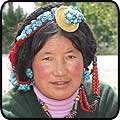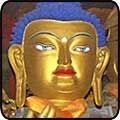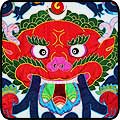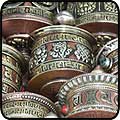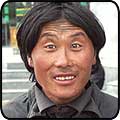
3 Days in Lhasa
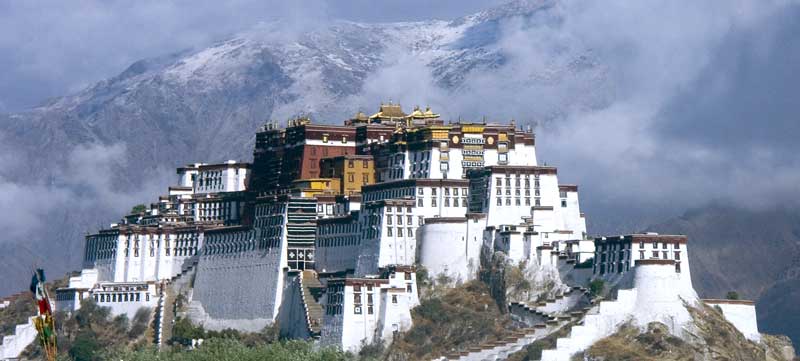
We arrived in Lhasa from the hot and humid Chengdu, and the air was clearly different - much cooler and fresher. It took two hours to get there from the airport through the barren and arid hills. The next morning Lhasa greeted us with low cloud and rain, but as soon as it cleared we looked with awe at the fairy-tale fortress of Potala (pictured above), visible from our hotel roof. The surrounding mountains were covered by fresh snow. Lhasa is 3,650m (12,000 ft) above sea level and we would spend a full three days here to acclimatise.
The effects of altitude were immediately obvious - two flights of stairs left us dizzy and breathless. Hotel Dhood Gu was located in the warren of narrow streets in old Lhasa. The decor was equally breathtaking - carvings and paintings in the Tibetan style, pretty much like the ones we later saw in the Potala Palace. (Click here to see the lobby)There were pilgrims everywhere - an endless stream of people, nearly all with prayer wheels (some with two!), and offerings of yak butter for the temple lamps. Many were prostrating themselves on the pavement every few metres, particularly in front of the Potala and the entrance to the Jokhang Temple - the holiest shrine in Tibet (see photo). There are two 'pilgrims' circuits' in Lhasa - one goes through the old town and leads to the Jokhang Temple, and the other one surrounds the hill on top of which the Potala Palace was built. The latter contains endless rows of big, wall-mounted prayer wheels, which the pilgrims turn (see photo).
Incense burners are equally ubiquitous - the ones on the streets were really 'industrial size' - huge ovens burning aromatic herbs and bushes (see photo).
Needless to say, the narrow streets are full of market stalls offering everything a pilgrim might need: yak butter, prayer flags, prayer wheels, prayer shawls, tanghkas (religious pictures on fabric), prayer beads, incense, thermos flasks, mobile phones...
There were very few Western toursits. Most were besieged by peddlers of all sorts of Tibetan memorabilia. I myself hardly escaped a siege of 5 little girls aged 5-10, who physically prevented me from moving until I bought something.
The Potala Palace is a state museum now, but a lot of pilgrims come here as 'tourists' to worship in the holy chapels. The palace is massive, allegedly with 1000 rooms, and contains the private apartments of the Dalai Lama - in exile since 1959. We were not allowed on the roof, which offers magnificent views of the town below and the surrounding mountains, but instead I saw something which will stay with me for the rest of my life. The roof was being repaired and there was a large group of workers there (around 30). They were flattening the special type of clay put there before the felt. When stamping their feet in unison they sang. The song was more of a chant and was done in two voices - male and female. It was one of the most mesmerising memories of Tibet for me. I couldn't take my eyes off them. The chant was spontaneous and of rare beauty, coming straight from their hearts and flying to the big, blue sky. To see what I saw click here.
In the afternoon of the first day we went to see the Sera monastery some 5 km north of Lhasa. Unlike the Potala this is a 'living' monastery and there we saw monks in a debating practice. The courtyard was full of novices in their late teens and early 20s (maybe 100 of them) in groups of 3 or 4, challenging one another on matters of scripture. The challenger stood up and made a gesture as if to hit the oponent making a loud clasp with his hands, while his adversary remained seated. The arguments were heated and very loud. Now multiply this by a hundred... you get the picture?
On the last day we joined the pilgrims to visit the Jokhang Temple, the holiest shrine in Tibet dating back to the VII Century. The reverence and devotion of the pilgrims was clearly visible. There was a lot of prostrating and turning of the prayer wheels. You could tell that many of these people marched for days from the far corners of Tibet (which is the size of Western Europe) to come here. Inside the air was thick with the smoke of the butter lamps, and long queues formed for the most holy chapel, a visit to which is believed to bring back health and prosperity. The temple has a large courtyard painted in the most vivid colours (see a fragment here) and its own 'prayer-wheel circuit' (see some of it here). The roof is a kingdom in itself - on several levels with a labirynth of steps and wonedrful views of Lhasa and a chance to take a closer look and some of its ornaments (see photo).
There was a lot of hustle and bustle in Lhasa and dozens of people everywhere. Soon we were to leave all this behind and head for the solitude of the mountains.
Visit
my Portrait Gallery of the Tibetans

